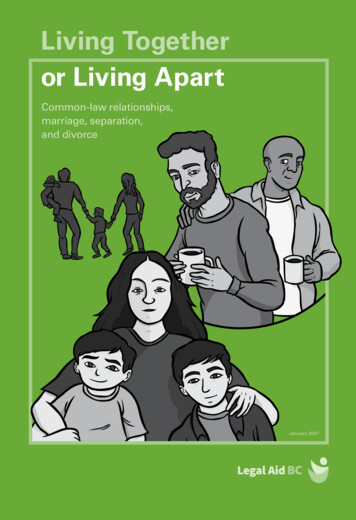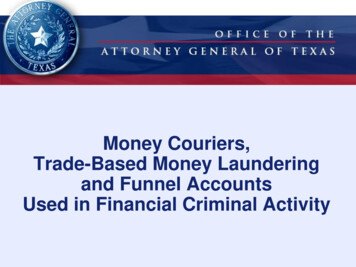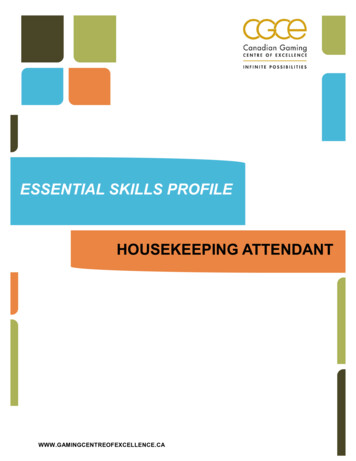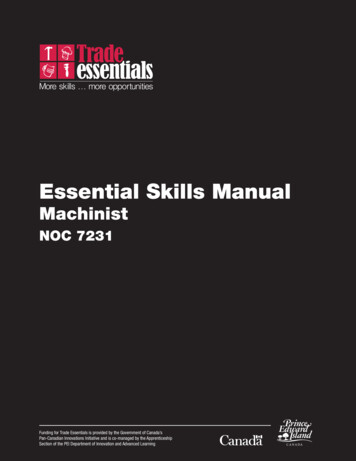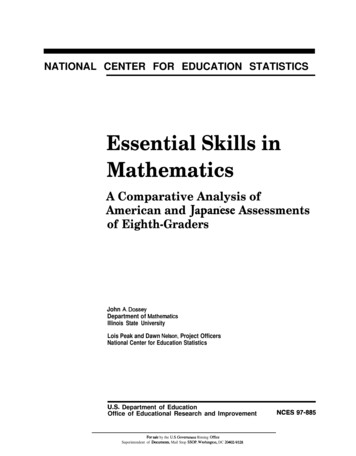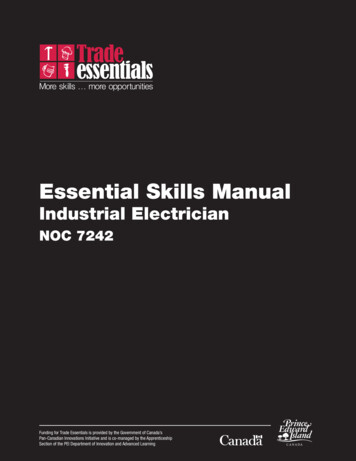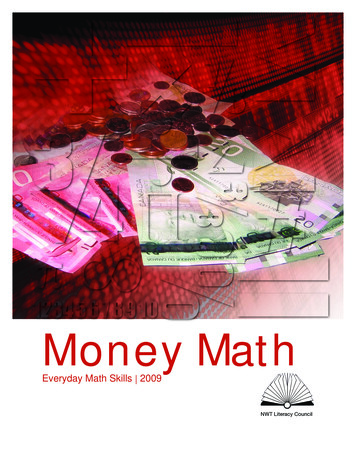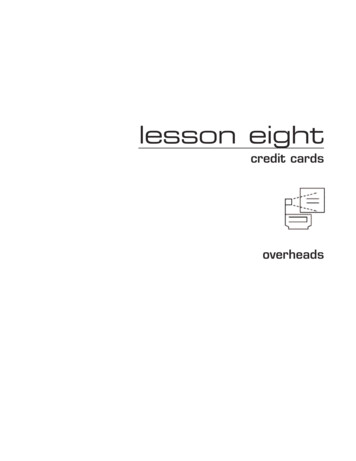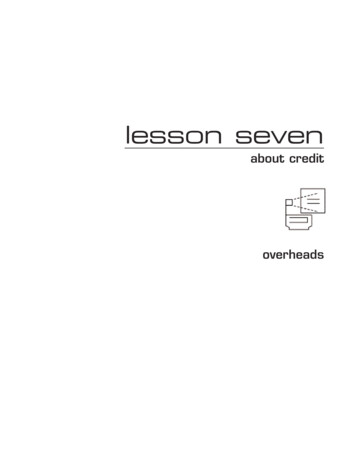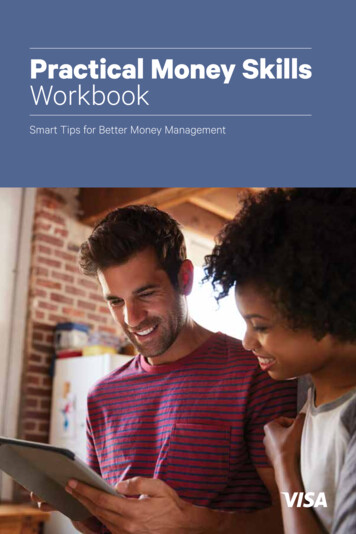
Transcription
MONEY MANAGEMENTKANSAS STATE UNIVERSITY AGRICULTURAL EXPERIMENT STATION AND COOPERATIVE EXTENSION SERVICE
AcknowledgmentsOriginally by:By: Mary Lou Odle, Saline County Extension Agent, Family and Consumer Sciences, K-StateResearch and Extension; and Joyce E. Jones, Extension Specialist, Family Financial Management,K-State Research and ExtensionRevised by Elizabeth Kiss, financial resources specialist, K-State Research and Extension
ContentsESSENTIAL LIVING SKILLS – MONEY MANAGEMENT4 Leader’s Guide5 Overview6 Budgeting Basics10 Banking Basics15 Record Keeping: The Facts of Your Life20 Activities and Fact Sheets21 Budgeting Basics24 Activity: Budgeting Basics26 Budgeting Basics: Wants, Needs, Goals28 Activity: Net Worth29 Activity: What Do I/We Owe?30 Activity: Tracking Your Daily Spending31 Activity: Budget32 Activity: Budget (Income)33 Activity: Budget (Expenses and Savings)34 Activity: Calendar of Monthly Income & Expenses35 Activity: Yearly Calendar of Expenses36 Activity: Does Your Money Have Wings?37 Budgeting Basics: Saving for Tomorrow38 Budgeting Basics: Saving for Tomorrow41 Activity: Money Saving Suggestions44 Budgeting Basics: Increase Your Income; Don’t Fallfor a Scam46 Budgeting Basics: Getting Help48 Budgeting Basics: Insurance51 Budgeting Basics: Rent-to-Own53 Budgeting Basics: The Cost of Moving56 Activity: The Cost of Moving59 Banking Basics: Deciding How to Pay68 Banking Basics: When Are Deposits Available70 Activity: Selecting a Checking Account72 Banking Basics Managing a Checking Account80 Banking Basics: Direct Deposit81 Record Keeping: The Facts of Your Life81 When Do You Need Important Records?82 Record Keeping: The Facts of Your Life82 How Long Should You Keep Important Records?84 Activity: Do You Know Where These Important Records Are?85 Record Keeping: The Facts of Your Life85 Where Should You Keep Important Records?88 Record Keeping: The Facts of Your Life88 Sample Filing System90 Evaluation3
Section 1LEADER’S GUIDE
Comments/NotesOVERVIEWPURPOSE OF THE LESSONThe Essential Living Skills: Money Management curriculum has three modules, including: Budgeting Basics Banking Basics Record Keeping: The Facts of Your LifeFor each module, you will find: objectives; fact sheets,worksheets, activity sheets, and sample lesson plans. The EssentialLiving Skills: Money Management materials may be used for selfstudy or for presentation and discussion at educational sessions.Copy fact sheets, worksheets, and activity sheets for distribution,as needed.Evaluation instruments also are included to measure progresstoward the stated objectives for each module. The evaluation hasseveral parts: Ask participants to fill out the Essential Living Skills: MoneyManagement evaluation (Identifying My Need to KnowMore About Basic Money Management Principles andSkills), which is designed to help determine which modules(and which parts of each module) best fit their needs. Thereis only one of these forms for the entire Money Managementlife skills curriculum, since it addresses all four modules. For each of the modules where a participant indicated a needto know more about that area, use the following evaluationforms: Shortly before the lessons (or before they have been providedwith the fact sheets and other materials to read and completeon their own, if that is what they prefer), have participantscomplete: An Assessment of How My Money Management ActivitiesAffect My Family’s Health and Well-Being My Plans For Improving My Skills Shortly after the lessons (or after they have been providedwith the fact sheets and other materials, assuming you areable to “track” them), ask the participants to fill out the formentitled Evaluating My Progress Toward Meeting My Goals. Six-months and 12-months after the classes (or after theyhave been provided with the fact sheets and other materials,assuming you are able to “track” them), have participantsagain complete the evaluation form An Assessment of HowMy Money Management Activities Affect My Family’sHealth and Well-Being.Essential Living Skills: Money Management5
Comments/NotesBUDGETING BASICSOBJECTIVESThe objectives of the Budgeting Basics module are to helpparticipants: List financial goals for the family. Track spending to determine how money is spent. Set up a budget or spending plan. Determine if and when expenses can be reduced. Develop a reasonable savings plan to meet emergencies andgoals.To help achieve these objectives, the following fact sheets,worksheets, and activity sheets are included: Budgeting Basics Getting Started You and Your Money Quiz Wants, Needs, Goals Net Worth What Do I/We Owe? Track Your Daily Spending Budget Budget Worksheet (Income) Budget Worksheet (Expenses and Savings) Calendar of Monthly Income and Expenses Yearly Calendar of Expenses Does Your Money Have Wings? Saving for Tomorrow Money Saving Suggestions Increase Your Income; Don’t Fall for a Scam Getting Help Insurance Rent-to-Own The Cost of Moving The Cost of Moving WorksheetFollowing is a suggestion for three Budgeting Basics educationalsessions.6Essential Living Skills: Money Management
SESSION IComments/NotesUse the following fact sheets, worksheets, and activity sheets: Budgeting Basics You and Your Money Quiz Wants, Needs, Goals Tracking Your Spending Does Your Money Have Wings?TEACHING POINTS:Hand out An Assessment of How My Money ManagementActivities Affect My Family’s Health and Well-Being and the Youand Your Money Quiz as they enter the room. Ask them tocomplete the evaluation first; then the quiz.Discuss the Budgeting Basics fact sheet. Stress that how wemanage our money is an individual matter, but very importantpart of our lives.Discuss the You and Your Money Quiz. Point out that familymembers often have very different approaches to moneymanagement. Suggest that participants discuss this quiz withtheir families to see how they would answer.Discuss Wants, Needs, Goals. Explain the difference between awant and a need. Have participants list several things they wouldlike to buy. You might want to add to the list. Go over the listand ask if they think it is a want or a need. You also could have alist of several items such as a cellphone, a cellphone with limitedminutes, texts, and data, and a cellphone with unlimited minutes,texts, and data. Read the list and have participants indicate if it isa want or need.Discuss goals and the differences between immediate, shortterm, and long-term goals. List some goals in each category, withinput from the audience. Ask participants to list at least threegoals in each category for the next session.Hand out Tracking Your Spending. Show how to fold a 8 1/2” by11” sheet to get eight spaces (by folding three times) and writethe days of the week on each space.Ask participants to keep track of everything they spend forat least two weeks — a month is better. Suggest other familymembers also track their spending.Discuss Does Your Money Have Wings? Go through some of theitems listed. Ask participants what items costs and how manytimes they usually purchase them. Add up yearly costs. Ask whatthey could buy with the money they saved from cutting back orcutting out something listed. Discuss remainder of sheet.Essential Living Skills: Money Management7
For the next session, ask participants to bring their weeklyspending record (from Tracking Your Spending), plus informationabout other regular monthly expenses.SESSION IIUse the following fact sheets and worksheets: Net Worth What Do I/We Owe? Getting Started Budget Budget Worksheet (Income) Budget Worksheet (Expenses and Savings) Calendar of Monthly Income and Expenses Yearly Calendar of ExpensesTEACHING POINTSTalk about the What Do I/We Owe? worksheet and what shouldbe listed on it to help participants see their total debt obligation.Ask them to complete the worksheet either in class or at home.Show the Net Worth form. This summarizes what they ownversus what they owe. Look at Getting Started and discuss.Discuss the Budget Worksheet (Income) and Budget Worksheet(Expenses and Savings). Explain the various categories and howthey can be changed to fit the participant’s family situation.The Budget worksheet is basically an overall view of the totals onthe worksheets and helps determine if participants need to reduceexpenses or increase income.Talk about how to use the Calendar of Monthly Income andExpenses to list when income is received and when bills needto be paid. Do a sample of a weekly paycheck and how to paymonthly bills, such as rent. List several bills that will occur eachweek. To the right of each week, list how much is left over afterpaying bills. Suggest when a bill arrives, participants put it onthe calendar for the day it must be paid, not the day it is due (toavoid late fees). Circle the bill and amount when it is paid.Point out that the Yearly Calendar of Expenses is designed to helpparticipants be aware when occasional expenses arise and howmoney needs to be saved each month to meet them. Have eachparticipant start filling in this calendar.For next session, ask participants to complete the three budgetworksheets and the Yearly Calendar of Expenses.8Essential Living Skills: Money ManagementComments/Notes
SESSION IIIComments/NotesUse the following fact sheets and worksheets: Saving for Tomorrow Money Saving Suggestions Increase Your Income; Don’t Fall For a Scam Getting Help Insurance Rent-to-Own The Cost of Moving The Cost of Moving WorksheetTEACHING POINTSReview budgeting forms. Discuss what participants discoveredabout their budget. Ask them for suggestions on how they couldchange their spending.Use the Saving for Tomorrow fact sheet and discuss how savingeven small amounts can add up over time.Go over the Money Saving Suggestions worksheet. Pick a fewstatements from each category and discuss.Ask for ideas on how participants can increase their income andwhat opportunities may be a “scam.” Bring newspaper ads thatsound suspicious.Use the Getting Help fact sheet to explore the many agencies,organizations, and groups in your area that offer assistance.Check out local agencies, organizations, and groups; then addthem to the list.Ask if anyone has used rent-to-own. Discuss advantages anddisadvantages.Ask if any participants have moved recently (or plan to do so inthe near future). Discuss The Cost of Moving fact sheet. Go overThe Cost of Moving Worksheet and suggest they use it when theymove. It is an easy way to keep track of what has to be done, aswell as the cost of moving.Urge participants to contact you if they have any moneymanagement questions.Essential Living Skills: Money Management9
Comments/NotesBANKING BASICSOBJECTIVESThe objectives of the Banking Basics module are to helpparticipants: Identify and evaluate the various ways to make purchases andpay bills. Know how to select a checking account that best fits theirneeds. Learn how to manage a checking account.The following fact sheets and a worksheet are included: Deciding How To Pay When Are Deposits Available? Selecting a Checking Account Managing a Checking Account Electronic Transfer Accounts (ETAs)Following are some suggestion for two educational sessions onBanking Basics. You may want to expand it to three (or more)sessions, depending on the number of activities you choose toinclude.10Essential Living Skills: Money Management
SESSION IComments/NotesUse the following fact sheets: Deciding How To Pay Electronic Transfer Accounts (ETAs)TEACHING POINTSProvide copies of the two fact sheets, Deciding How To Pay andElectronic Transfer Accounts (ETAs). Explore with participantsthe various ways to make purchases and pay bills. Focus thediscussion around the questions below. You might want tosummarize these points on newsprint, a chalkboard, dry eraseboard, or an overhead transparency. What are the advantages and disadvantages of using eachmethod of payment? How do they compare against eachother? How do they work? Are they convenient? How easy ordifficult are they to manage? What are the costs? Are these costs different locally? IfI don’t manage the payment method wisely, what are thepossible consequences? What records will there be of transactions? How easy or hardwill it be to keep track of these transactions? Are there safety issues to consider? What other factors influence whether I use a particularmethod of payment or not?As an alternative, you could develop a few case studies and askparticipants what payment method would be appropriate in thisparticular situation and why. Again, try to address some of thequestions already mentioned.Pay attention to how the group responds. What do the responsestell you about their past experience with, or willingness toconsider, this type of payment method? Acknowledge theirfeelings and experiences.Gather (or have participants who have signed up to attend theeducational session gather) local data on costs of the variouspayment methods in your community, such as the cost of moneyorders and cashier’s checks, check cashing fees, ATM and debitcard fees, service charges, stop payment requests, “insufficientfunds” fees, and others. In some cases, this may mean gatheringcopies of brochures and disclosure information from financialinstitutions and businesses.If some participants have never used Electronic Funds Transfer,such as using an ATM card, a debit card, or electronic billEssential Living Skills: Money Management11
payment service, you might want to arrange a field trip to a localbusiness or financial institution that has the systems in place. Seeif the manager or other employee could explain how the systemworks.While not discussed in the Deciding How To Pay fact sheet,questions may arise about the Kansas Benefits card. This isanother type of Electronic Fund Transfer card. The KansasBenefits card is more correctly referred to as an ElectronicBenefit Transfer (EBT) card.Families who receive food stamp benefi
My Money Management Activities Affect My Family’s Health and Well-Being. OVERVIEW. 6. Essential Living Skills: Money Management Comments/Notes OBJECTIVES The objectives of the Budgeting Basics module are to help . participants: List financial goals for the family. Track spending to determine how money is spent. Set up a budget or spending plan. Determine if and when expenses .
